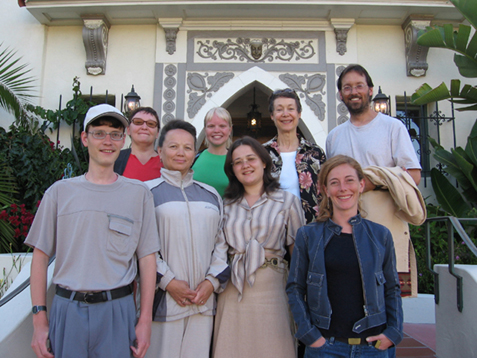NCEAS Working Groups
The 60-year data set of plankton dynamics in Lake Baikal: Examining facets of the jewel of Siberia
Project Description
Three generations of a single family of Siberian researchers have been monitoring water quality and microscopic life in Lake Baikal, the world's oldest and largest lake, over the past 60 years. More than 25 million years old, Lake Baikal is almost a mile deep (> 1600 meters) and spans 4 degrees of latitude; the volume could fill all of the Great Lakes in the United States. Approximately every two weeks, Dr. Lyubov Izmest'eva's research team at Irkutsk State University ventures onto this vast lake in a research boat - or across the ice in winter - to collect water samples and analyze them back in their laboratory, just as Dr. Izmest'eva's mother and grandfather did before her. As a result of this family's hard work and dedication, we are now able to use this incredible legacy of data to understand how the world's largest freshwater lake has responded to major environmental disturbances such as pollution and climate change in the past half century. Such an understanding is important not only because Lake Baikal itself is such a special place - harboring higher biological diversity than any other lake, including the world's only freshwater seal - but also because analyzing this detailed data set helps us to predict how other lakes may respond to similar disturbances that threaten freshwater systems worldwide.
In July 2006, Stephanie Hampton (UCSB), Marianne Moore (Wellesley College) and Brian Dennis (University of Idaho) traveled to Siberia to meet with the Russian team on Lake Baikal. We carried out our NCEAS working group activities there for the first time - the Siberian researchers have traveled to Santa Barbara twice before (July 2005 and January 2006) to meet at NCEAS. This time the Americans endured the long trip to Siberia and finally experienced the grandeur of this amazing place. An advantage of us traveling to Lake Baikal was that we were able to meet with many Russian scientists we would not have otherwise met, and speak with them through translators, enriching our understanding of the ecosystem and the scientific culture of Russia.

Principal Investigator(s)
Evgeny A. Zilov, Stephanie E. Hampton, Marianne V. Moore
Project Dates
Start: July 9, 2005
End: January 21, 2009
completed
Participants
- Brian Dennis
- University of Idaho
- Stephanie E. Hampton
- University of California, Santa Barbara
- Cheryl Hojnowski
- Wild Salmon Center
- Lyubov R. Izmestyeva
- Irkutsk State University
- Yelena Kashtuyeva
- University of California, Los Angeles
- Stephen L. Katz
- NOAA, National Marine Sanctuary Channel Islands
- Elena Litchman
- Michigan State University
- Andrey V. Mokryy
- Irkutsk State University
- Marianne V. Moore
- Wellesley College
- Anna Paromchuk
- Irkutsk State University
- Ekaterina V. Peshkova
- Irkutsk State University
- Adrien I. Smith
- Unknown
- Evgeny A. Zilov
- Irkutsk State University
Products
-
Presentations / 2006
Long-term changes in the pelagic zone of Lake Baikal
-
Presentations / 2008
Long-term warming and deepening summer phytoplankton distribution in Lake Baikal, Siberia
-
Presentations / 2008
Long-term warming and food web reorganization in the world’s largest freshwater lake– L. Baikal, Siberia
-
Journal Article / 2008
Sixty years of environmental change in the world's largest freshwater lake - Lake Baikal, Siberia
-
Data Set / 2006
Lake Baikal plankton
-
Journal Article / 2006
Seasonal dynamics of common phytoplankton in Lake Baikal
-
Presentations / 2008
Climate change and phytoplankton community structure in Lake Baikal, Siberia
-
Presentations / 2008
Long-distance climate teleconnection deciphered through non-stationary long-term environmental data from Lake Baikal, Siberia
-
Journal Article / 2011
Influence of Long-Distance Climate Teleconnection on Seasonality of Water Temperature in the World's Largest Lake - Lake Baikal, Siberia
-
Presentations / 2007
Sixty years of environmental change at Lake Baikal: Tarnishing the pearl of Siberia
-
Presentations / 2007
Sixty years of environmental change in the sacred sea of siberia
-
Presentations / 2007
Synergistic effects of climate change and anthropogenic stressors on Lake Baikal, Siberia
-
Presentations / 2008
Potential effects of contemporary climate change on Lake Baikal, Siberia
-
Presentations / 2009
Climate change and the ‘sacred sea’ of Siberia
-
Journal Article / 2009
Climate change and the world's 'sacred sea' Lake Baikal, Siberia
-
Presentations / 2009
Tales from Siberia: Climate change and the world’s largest lake
-
Presentations / 2010
Science without boundaries in a changing world
